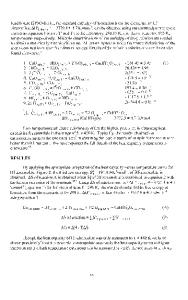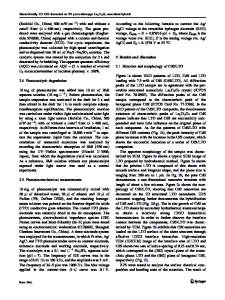La 2 Hf 2 O 7 :Ti 4+ ceramic scintillator for x-ray imaging
- PDF / 724,579 Bytes
- 4 Pages / 612 x 792 pts (letter) Page_size
- 68 Downloads / 393 Views
Transparent ceramic scintillators of La2Hf2O7:Ti4+ were developed by a novel combustion synthesis method. The optical transmittance for a 1.0-mm-thick specimen is about 60% of the incident light, and the x-ray stopping power is also quiet high. The broad emission band centered at 475 nm originates from the oxide-Ti4+ charge-transfer transitions, which renders fast decay time on the order of 10 s. The highest relative light output has reached about 1.5 times that of Bi4Ge3O12 (BGO) single crystal when excited by 120 kV x-rays.
X-ray computed tomography (CT) creates a crosssectional image by digitally imaging the x-ray absorption coefficient in a particular part of the human body. The performance of an x-ray CT is strongly influenced by its x-ray detectors. At present, most x-ray CTs have used solid-state detectors constructed using scintillators coupled to Si photodiode arrays. X-ray energy is first converted to light energy, and then the light energy is converted to electric current by the Si photodiode. The desirable properties required for scintillator materials in x-ray CT detectors are (i) high light output, (ii) low afterglow, (iii) high x-ray absorption efficiency, (iv) low radiation damage, (v) high uniformity, (vi) high machinability, (vii) chemical stability, and (viii) a spectral match to the sensitivity of Si photodiodes.1,2 Scintillators in single-crystal form have excellent optical transparency and were once used for x-ray CT detectors. In recent years, many single-crystal scintillators with fast decay time and high light output have been reported.3–6 However, it is rather difficult, if not impossible, to grow single-crystal scintillator materials with uniform chemistry to control the critical properties of afterglow, radiation damage, and x-ray hysteresis. The ceramic route provides a practical option of evaluating multicomponent chemical compositions and dopants to tailor the scintillator properties of the host material. Recently, ceramic scintillators, such as (Y,Gd)2O3:Eu,2 Gd2O2S:Pr,Ce,F,7 have been developed for x-ray CT detectors. Transparent (Y,Gd)2O3:Eu is the first ceramic scintillator used for medical x-ray CT detectors. Its high light output combined with excellent transparency and the low values of afterglow and radiation damage allows
(Y,Gd)2O3:Eu ceramic to be widely used in commercial x-ray CT scanners.2 However, its slow decay time of ∼1 ms cannot meet the requirements of current fast-speed x-ray CT detectors. The newly developed Pr3+-activated Gd2O2S ceramic scintillator is the second ceramic scintillator used in CT scanners.7 The Pr3+ in the lattice of Gd2O2S exhibits a blue-green transition between states of the same multiplicity (3Pj–3Hk), which renders high light output superior to that of CdWO4 and fast decay time on the order of 4 s. Unfortunately, the hexagonal oxysulfide cannot be sintered into fully transparent ceramics. Ti4+-activated La2Hf2O7 powder has an efficient emission and high x-ray stopping power. It was found that the output of La2Hf2O7:2%Ti reaches 1.6 times tha
Data Loading...











